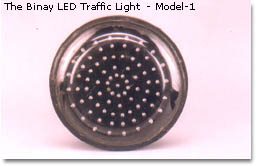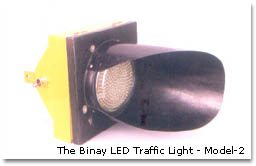| Binay LED TRAFFIC LIGHT
The Binay LED (Light Emitting Diode) Traffic Light is a long-life, solid-state unit which can easily be retrofitted into the existing filament light receptacle in the conventional traffic light signal unit  Conventional 100W filament or halogen incandes-cent
bulbs used in traffic lights have a limited life, and thus require regular
maintenance. Conse-quently, LED matrix traffic lights have been devel-oped
in view of their long life and low power con-sumption. Conventional 100W filament or halogen incandes-cent
bulbs used in traffic lights have a limited life, and thus require regular
maintenance. Conse-quently, LED matrix traffic lights have been devel-oped
in view of their long life and low power con-sumption.The Binay LED Traffic Light has been designed as per the requirements of the American Institute of Transport Engineers (ITE), which has laid down a provisional specification for such light heads run-ning either on 12VDC or 115VAC. The specification defines minimum light intensities required for day time visibility (at distances of 300 to 600m), a view-ing angle of 30 degrees, colours defined by co-ordinates on the CIE 1931 chromaticity diagram, and the use of proper LEDs to withstand wide variations of ambient temperature.  The main advantages of LEDs are long life
(nor-mally 11 years on a continuous burning basis) and
low wattage (less than 24 watts, or even as low as 7-8
watts for certain types). As such, the high initial cost is amortised
through the elimination of the high maintenance costs, which are a normal
feature of the conventional filament bulb traffic light (which re-quires
frequent replacement of the bulb). Authorities in the USA have calculated
that the payback period is only one or two years. The main advantages of LEDs are long life
(nor-mally 11 years on a continuous burning basis) and
low wattage (less than 24 watts, or even as low as 7-8
watts for certain types). As such, the high initial cost is amortised
through the elimination of the high maintenance costs, which are a normal
feature of the conventional filament bulb traffic light (which re-quires
frequent replacement of the bulb). Authorities in the USA have calculated
that the payback period is only one or two years.
Even more important, however, is the fact that the high reliability greatly reduces the possibility of traf-fic accidents which are likely in the case of a possi-ble failure of filament bulbs (particularly on highways with fast traffic). The reliability of the Binay LED Traffic Light is further enhanced due to the fact that multiple parallel circuits are employed in the design. There are as many as 40 to 50 circuits (even in the 12V model); as such, the failure of any one circuit decreases the light intensity by only 2 to 3 percent. Moreover, the 12V model can easily be operated with solar power systems. The Binay LED Matrix Traffic Light is a flange type unit which can be retrofitted exactly in place of the existing glass lens in the traffic light housing. It is available in 200mm and 300mm diameter models, and also in lower intensities (for use at less impor-tant road intersections). Since LEDs in 'traffic' blue-green colour are expensive, price economies can be achieved by utilising signs such as arrows, which can be designed with fewer LEDs. Pedestrian signs are also available. |